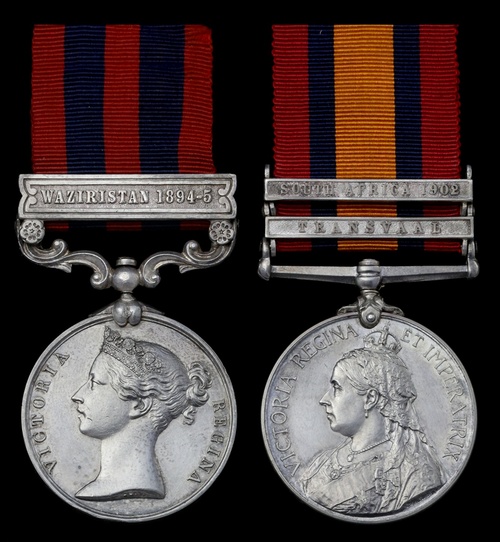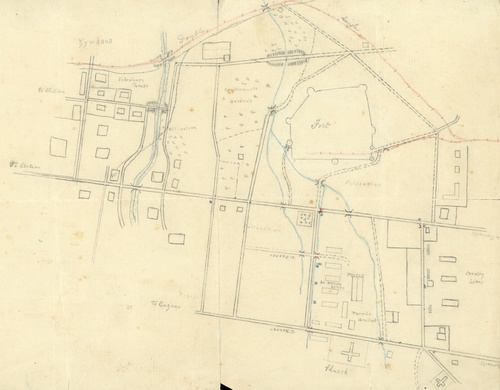Auction: 19003 - Orders, Decorations and Medals
Lot: 172
A fascinating North-West Frontier and Second Boer War pair to Private F. Lamb, The Border Regiment, who kept a first-hand account and drew intricate plans of the network of Blockhouses in which he served
India General Service 1854-95, 1 clasp, Waziristan 1894-5 (3355 Pte. F. Lamb, 2d. Bn. Border Regt.); Queen's South Africa 1899-1902, 2 clasps, Transvaal, South Africa 1902 (3355 Pte. F. Lamb. Border Regt.), scratch on rim, obscuring part of number, extremely fine (2)
Francis (Frank) Lamb was born in Ashorne, Leamington, Warwickshire in 1874. He attended an Elementary Day School, gaining 'Excellent' marks in geometry, model drawing and freehand drawing. He would apply these skills to great effect during his army career. After working in a Birmingham factory as a tube drawer, he attested for the Border Regiment at Carlisle on 25 January 1892, joining the 1st Battalion from the Depot on 2 May 1892. Based at Woolwich in 1893, he transferred to the 2nd Battalion, sailing from Portsmouth aboard S.S. Bothnia on 31 January 1894 and arriving in India on 14 March.
During the previous year, a British diplomat named Mortimer Durand had redrawn Afghanistan's eastern border, known thereafter as 'The Durand Line'. This boundary affirmed Afghanistan's status as a buffer zone in the 'Great Game' between Britain and Russia. It was concluded by a single-page 7-point agreement signed by Adbur Rahman Khan, Amir of Afghanistan, on 12 November 1893. A vast demarcation survey then took place, led by the Afghan Frontier Delimitation Party under Colonel A. H. Turner. On 3 November 1894, Turner's force was attacked in its camp at Wana by Waziri tribesmen, and a desperate battle ensued. Lieutenant-General Sir William Lockhart rapidly assembled a Waziristan Field Force, which included the 2nd Battalion, Border Regiment. Private Lamb served in Waziristan until 13 March 1895, when peace was concluded and the border re-established. The Durand Line is internationally recognised to this day.
Promoted to Lance-Corporal on 1 June 1898, Lamb reverted to Private at his own request, transferring to the 1st Battalion on 3 March 1902. At Bombay on 18 March, he boarded S.S. Tagus, bound for Durban in South Africa. He disembarked there on 30 March. Keeping a diary, he remarked: 'Durban seemed a very nice place but they did not give us much time to look round, they packed us in trains and we left the same afternoon as disembarking.' On 3 April, the Battalion moved into the Litchenberg Blockhouse, which it garrisoned for three months. Designed by General Sir Elliot Wood, the Blockhouse was used to guard strategic points and impede the movement of Boer commandos. Some 8,000 of them were built by the British in two years. Lamb drew plans of his blockhouse and described it in minute detail:
'The Blockhouse is made of corrugated Iron and is built in a circle of about 14 feet across, it is built double then filled in with shingle, in height it is about 7 foot 6 inches with a tarpaulin roof outside. At about 4 yards from the structure is a circular trench about 4 foot 4 inches deep and the earth thrown inwards sloping upwards, making the bottom part of the Blockhouse shell-proof while the top part is proof against rifle fire, the top part has port-holes at intervals so that the occupants can fire in every direction, over the trench is a network of barbed wire… Blockhouses are situated at 1,000 yard intervals, with a fencing and network [of barbed wire] from one to the other, so that it would seem impossible to break through.'
Lamb goes on to describe the intricacies of sentry duty. He admitted: 'Blockhouse life is very monotonous as there is no one to see.' The Blockhouses, intended as a deterrent, evidently did their job! On 1 June, news reached Litchenberg of the Peace concluded with the Boers at Pretoria the previous day. Lamb's Battalion sailed from Cape Town aboard H.M.S. Norman on 13 August, reaching Southampton on 29 August. Discharged on 24 January 1904, Lamb took up residence in Coventry and continued to educate himself, becoming an Inspector of Aircraft Works. He died at 64 Southbank Road, Coventry on 17 March 1946.
Sold with an interesting archive, including:
(i)
Lamb's handwritten pocket diary, describing Blockhouse design and including a transcription of Kipling's poem: The Storming of the Malakand.
(ii)
Four maps hand-drawn by Lamb, showing the military encampment at Quetta (illustrated).
(iii)
An original programme for the Memorial Service held at Bareilly on the day of Queen Victoria's Funeral, 2 February 1901.
(iv)
Two black-and-white photographs, possibly taken by Lamb, of Indian women employed in weaving at Assam.
(v)
A Ministry of Health certificate and paperwork confirming Lamb's entitlement to an Old Age Pension, dated 8 December 1938.
(vi)
Three school certificates, dated 1885, confirming Lamb's 'excellent' exam results.
(vii)
Lamb's copied enlistment and service papers.
Subject to 20% VAT on Buyer’s Premium. For more information please view Terms and Conditions for Buyers.
Sold for
£360
Starting price
£280







